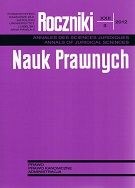Dyskryminacja bezpośrednia i pośrednia jako problem prawny i społeczny
Direct and Indirect Types of Discrimination as Legal and Social Problems
Author(s): Anna Daniluk-Jarmoniuk, Anna Pacian, Jolanta PacianSubject(s): Law, Constitution, Jurisprudence
Published by: Towarzystwo Naukowe KUL & Katolicki Uniwersytet Lubelski Jana Pawła II
Keywords: discrimination; employment; disproportion
Summary/Abstract: The goal of the article is to present legal regulations regarding direct and indirect discrimination, and discuss discrimination as a social problem. Direct discrimination occurs in the individual relation between an employee and his or her employer, or between a job-seeker and a potential employer. Such discrimination exists when an employer disadvantages an employee by presenting a biased attitude to his or her situation which is mentioned in Article 183a of the Labour Code. Under Art. 18 [3a] § 4, indirect discrimination occurs when as a result of an apparently neutral decision, criterion or action, unfavourable disproportion or a particularly adverse situation occurs or may have occurred regarding establishment or termination of one’s employment, conditions of employment, promotion, and access to training to raise one’s qualifications, affecting all or a majority of employees who belong to a particular group. Apart from numerous negative consequences of legal nature, discrimination contributes to a degradation of both physical and mental condition. It is a factor that contributes to depression, increased divorce rate and other forms of pathology.
Journal: Roczniki Nauk Prawnych
- Issue Year: 22/2012
- Issue No: 3
- Page Range: 79-92
- Page Count: 14
- Language: Polish

